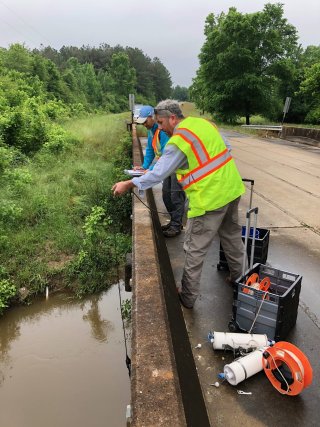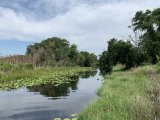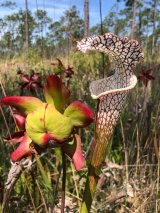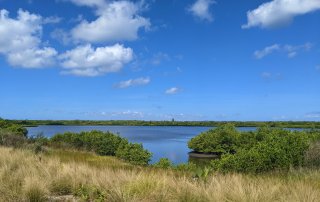Natural Resource Damage Assessment and RESTORE
Natural Resource Damage Assessment
The April 2010 explosion of the Deepwater Horizon (DWH) drilling rig resulted in the largest marine oil spill in U.S. history, causing the loss of 11 lives and extensive natural resource injuries. The oil spread from the deep ocean to the surface and nearshore environment from Texas to Florida, prompting an extensive response and Natural Resource Damage Assessment (NRDA). In 2016, the historic settlement in United States v. BPXP et al. required the company to pay up to $8.8 billion over 15 years—the largest ever for natural resource injuries.
The EPA, led by the Office of Water, supports eight Trustee Implementation Groups (TIGs) and serves as a member of the DWH NRDA Trustee Council. The Gulf of America Division (GAD) staff serve as primary and alternate EPA Trustee representatives on the TIGs for Alabama, Florida and Mississippi, as well as the Region-wide TIG. GAD staff provide technical expertise to the five Gulf states related to water quality, nutrient reduction, monitoring and adaptive management, and approaches to restore oysters and sturgeon injured by the oil spill.
Measurable results-oriented projects are being implemented to restore the Gulf of America ecosystem and the natural resources injured by the DWH oil spill. Projects include restoring and conserving habitat, restoring water quality, replenishing and protecting injured coastal and marine species, and providing and enhancing recreational opportunities.
GAD staff conducted water quality sampling for the Upper Pascagoula Water Quality Enhancement Project. This Mississippi TIG project restores damaged water quality by developing and implementing conservation plans and practices to reduce nutrient and sediment runoff into coastal waters from the Chunky-Okatibbee watersheds.

To learn more about NRDA, visit: www.gulfspillrestoration.noaa.gov.
RESTORE
Gulf Coast Ecosystem Restoration Council
Congress passed the Resources and Ecosystems Sustainability, Tourist Opportunities, and Revived Economies of the Gulf Coast Act of 2012 (RESTORE Act, 33 U.S. Code § 1321(t)) following the catastrophic 2010 Deepwater Horizon oil spill. The RESTORE Act establishes the Gulf Coast Ecosystem Restoration Council (the Council) and the Gulf Coast Restoration Trust Fund. The Council membership includes the governors of the states of Alabama, Florida, Louisiana, Mississippi and Texas. Other members include the secretaries of the U.S. Departments of Agriculture, Army, Commerce, Homeland Security and the Interior, and the Administrator for the EPA. The EPA serves as the chair of the Council. To learn more about the RESTORE Act or the Council, visit: www.RestoreTheGulf.gov.
Conservation Enhancement Grant Program
Awarded $2.5 million in 2021 with an additional $1.8 million in required match
This project will enhance public-private partnerships that support land protection and conservation across the Gulf Coast region via funding for the following projects:
Atlanta Botanical Garden: This project studies various vegetation removal and restoration techniques in coastal wetlands to determine impacts to ground layer vegetation, hydrology, amphibians, water quality and soil quality.
Bay Foundation: This project funds management, restoration and enhancement activities on 800 acres of habitat within GBF-owned lands, due diligence projects for future conservation acquisitions and one economic benefits report.

Partnership for Gulf Coast Land Conservation: This project funds due diligence for over 17 subawards for future permanent land acquisition with a goal of conserving over 20,000 acres. Two permanent acquisitions with over $6 million in value are complete.

The Nature Conservancy: This project funded restoration of over 2,100 linear feet of oyster reef habitat along rapidly eroding shorelines in Calcasieu Lake along Sabine National Wildlife Refuge, a priority landscape on the Gulf of America. Monitoring of oyster reef sustainability is ongoing.

Woodlands Conservancy: This project funds invasive species removal from 840 acres of forested wetlands within two properties, replanting of native vegetation, vegetation surveys via UAV, and bird banding and surveys.
Mobile Bay National Estuary Program (MBNEP)
Awarded $1.65 million in 2020
This project:
- Restored approximately 1,800 linear feet of stream on the headwaters of Twelve Mile Creek, a tributary of Three Mile Creek.
- Implements an extensive Invasive Species Control Plan in priority areas identified in the Three Mile Creek Watershed.
- Addresses stressors affecting water quality and habitat in the Three Mile Creek Watershed.
Pensacola & Perdido Bays Estuary Program (PPBEP)
Awarded $2 million in 2018
This project:
- Established the PPBEP Management Conference made up of the Policy Board, the Technical Advisory Committee, the Education and Outreach Committee and the Business Advisory Committee.
- Developed the Comprehensive Conservation Management Plan (CCMP), which was approved by its Policy Board in October 2022.
- Created five permanent positions that are filled.
Tampa Bay Estuary Program (TBEP)
Awarded $1.46 million in 2018

The TBEP implemented five water quality and habitat improvement projects throughout the Tampa Bay watersheds:
- Biosolids to Energy (City of St. Petersburg): Commissioning and performance monitoring of the newly constructed Biogas Upgrade System.
- Copeland Park Stormwater Enhancements (City of Tampa): Enhancement of drainage and water quality by shoreline restoration and littoral shelf development at Copeland Park Pond and shoreline native revegetation.
- Coastal Invasive Plant Removal/Cockroach Bay Aquatic Preserve (Hillsborough County): Removal of high priority invasive plants to reduce spread throughout the Tampa Bay ecosystem, and native revegetation.
- Robinson Preserve Water Quality and Habitat Restoration (Manatee County): Establishment of 14.8 acres of high-quality coastal uplands habitat and vegetation monitoring.
- Ft. De Soto Recirculation and Seagrass Recovery (Pinellas County): Improvement to water quality by hydrologic flow restoration between backwater bays, native revegetation, establishment of 200 acres of seagrass beds, and creation of a hydrodynamic model of circulation, over a two-year period.
